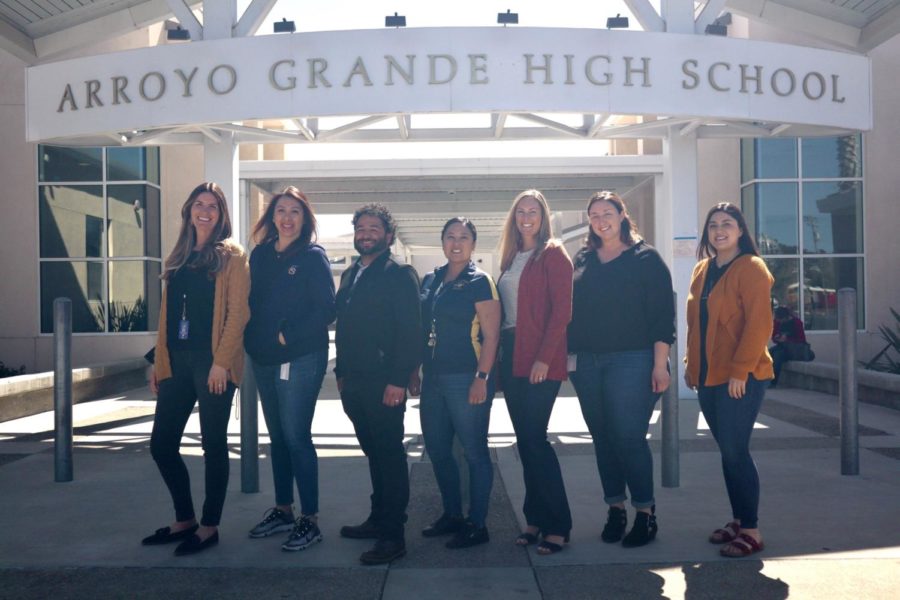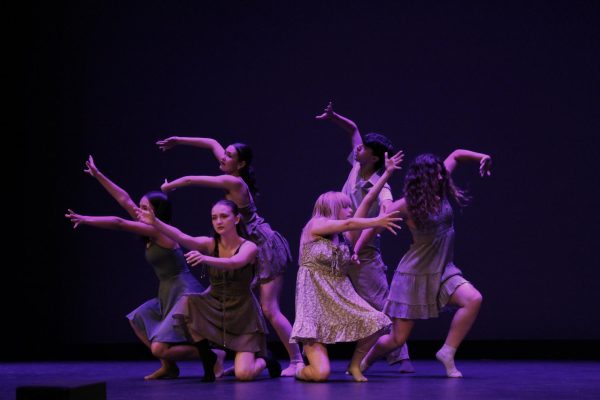Making do with just a few
1 in 5 American high schools have the ideal amount counselors—we’re not one of them.
Our counseling staff handles over 400 students each. Pictured from left to right: five counselors Labrado, Mosqueda, Alvarez, Molina, Penton, and secretaries Wagner and Gonzalez.
“I’ve always had the heart to give back and support,” AGHS counselor Jose Alvarez said. “There were principals, and teachers who were there for me and guided me regardless of what mistakes I made…those people inspire me to do that same thing and understand that we’re not perfect and people made mistakes… with the right support and love, they can make the right decisions and make a difference.”
AGHS welcomed Alvarez to its counseling department this year; however, the need for additional support and understanding is still present.
“I feel like the profession of a school counselor is brand new in perspective to a lot of things… people aren’t really aware of what counselors actually do,” Alvarez said.
According to the American School Counselor Association (ASCA), the ideal caseload is 250 students per counselor and across high schools, the average student-to-school counselor ratio is 311 students to 1. Only 1 in 5 American high school students are enrolled in a school where there are a sufficient number of school counselors.
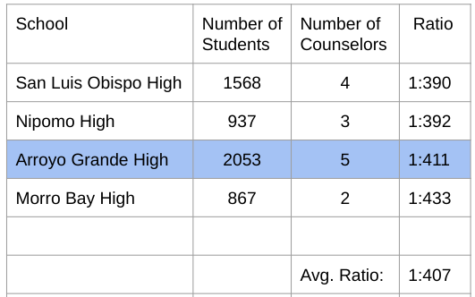
At AGHS, caseload numbers hover around 411 students for each counselor. While AGHS has more counselors than several nearby high schools, it is important to note that up until recently AGHS had 4 counselors— the same as San Luis Obispo High, despite having nearly 600 more students.
“We have wanted to be certified by the American School Counselor Association. But I don’t know if we ever could because of our caseload numbers…If we were ASCA certified, it would make our Department of Counseling more prestigious,” AGHS counselor Alyssa Labrado said.
“…[There are] definitely more [students on my caseload] than I wish I had because I can’t meet everybody’s needs when I have that many,” AGHS counselor Cristel Penton said.
While some schools have several different categories of counselors, AGHS counselors assume all roles.
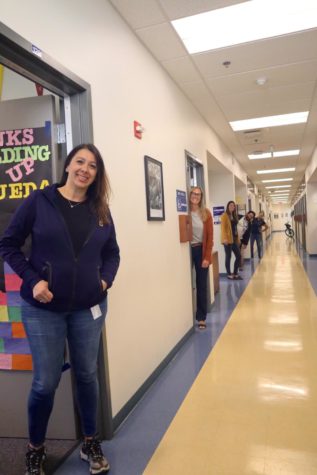
“… we do socio-emotional, college and career, and academic [counseling]…all of us are all three,” Molina said.
“In Santa Maria, they have 2700 students at their school, and they have eight counselors and two support counselors, meaning that they’ll take care of 504s and IEPs. In my caseload, I probably have close to maybe 50 to 60 [IEPs and 504 plans]…On average IEP case managers hold about 25.”
Along with undertaking double the 504 and IEP cases as the average case manager, Molina oversees a program to serve students with specific needs.
“The alternative education program …identifies students who may have socio-emotional needs… their situations tend to be a little bit more extreme… and could possibly prevent them from graduating… whether that be financial barriers, past history, [or] repressed trauma that may set them back,” Molina said.
“I take my students to Cuesta and Hancock, and we do career exploration days… I believe that when you take students off-campus who normally wouldn’t get to because of their grades, sometimes those little moments will plant the seed and change them.”
The alternative education program is an example of how counselors are trying to connect students with the proper resources they need.
“[We’re] mediator/advocate/mental health/counselor/community liaisons,” Penton said.
Counselors are qualified to act as liaisons, but they can’t address more critical cases themselves, as they aren’t professional therapists.
“…you could get a walk-in in the morning… [which] could be a full-on crisis…[it’s hard knowing] you’re only an ambulance driver for your severe socio-emotional cases,” Molina said. “ I’m not a licensed therapist, I’m a licensed counselor. We usually drive those severe situations to a resource and have them connect…with a therapist.”
When constant tasks and more immediate situations pull counselors in several directions, it can be difficult for them to establish a permanent schedule and take the other challenges their job presents in stride.
“…every second of my days are always pre-planned and if not planned, then working on the shift of a dime,” Molina said.
“I would say, the most challenging part of this job is trying not to feel completely ineffective,” Labrado said.
With a chaotic and unpredictable schedule, it’s important that counselors establish a clear boundary between their work and home lives.
“I have two children, eight and thirteen, so I have to prioritize my personal life as well… I can walk out of here totally exhausted and have nothing for my own family…I know from this perspective how important it is for parents to be present. If I’m not there for my own kids, then I’m just setting up my kids to feel that emptiness when they get to [high school] age,” Molina said.
While the stress of a counseling job may not be obvious from a student standpoint, counselors must make sure their mental health doesn’t get pushed aside while contributing to the mental well-being of their students.
“I have to set boundaries for my own sanity… I don’t know that everyone always understands… how hard we’re trying and how we truly have everyone’s best interests at heart,” Penton said.
Labrado feels that reducing the workload for counselors could allow for what she believes to be the counselors’ “more important job” of spending time keeping up with students.
“I think if there were to appoint one person for all the Cuesta registrations so that all the students who really want to take summer classes and classes during the year could know where to go to get that help [that would be helpful]. ”
While counselors are adamant about the need for a larger counseling staff to help spread out their caseloads and allow more attention for each individual student, budgeting issues provide a significant barrier.
“At the end of the day, it’s all about the state budget, and [the state says] they want to prioritize education, but I don’t feel like they do, so that’s frustrating,” Labrado said. “In a school district, the bulk of the money goes to teachers, which it should, because the teachers are really on the frontlines with students every day, but I feel like there isn’t money in the budget to allow for more counselors.”
If there were to be room in the budget to hire at least one more counselor, our current counseling staff feels it would allow them to foster deeper bonds with students.
“I wish we had six or seven counselors… that would mean fewer emails [and] more individual time with kids,” Penton said. “The mental health need is so much more than it normally is… if I had fewer kids, then I could really focus more on that.”
Because counselors have to acquire a specific skill set in order to perform their duties, their experience doesn’t come cheap.
“It’s not like you can [hire] anyone who just graduated with a degree in psychology… we all have master’s degrees and we all have our school counseling credentials. So having that all together is hard to find and it’s expensive,” Molina said.
This may be a reason why they risk getting cut when the budget gets tight.
“Historically, the school counselor position tends to be amongst that group of positions that gets pink slipped more often when the districts are having to face some budget cuts,” Head Counselor Yusdivia Mosqueda said.
Even with their large caseloads, each counselor has their own way of building rapport with students despite only seeing them a few times a year.
“I always look forward to [guidance talks] because I get to know students’ names and faces… I care about [the students] and [want] to know the things that they’re interested in,” Penton said. “I like scheduling meetings too because that’s where I get to have one on one conversations with you guys and I wish I had more time to do that.”
Alvarez hopes to connect with students individually more also, and he believes this can happen outside of the counseling office just as much as it does inside.
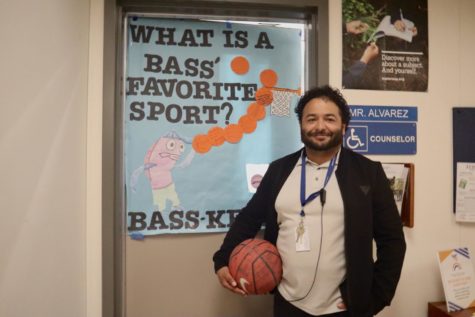
“I do tournaments and lunch…I did a basketball tournament. I’m planning on doing a soccer tournament soon…[also] I try to talk to students on the blacktop or wherever I see them. And when they come in, I try to get to know them, ask questions about what they want to do in life, their families, what they enjoy,” Alvarez said.
Labrado also does her best to make it known that she cares for her students as people and not just numbers in her caseload.
“[I like connecting by] attending events, seeing them out on the soccer field, or the football field or in a play,” Labrado said.
Student success both personally and academically is the ultimate goal for AGHS counselors.
“[I love when a student] gets through something really hard and then comes through on the other side, and I feel like I was able to work with them on that,” Penton said.
With the implementation of intern programs and fully utilizing other student assistance resources, the counselors hope to take steps towards deeper involvement with students until the more permanent solution of expanding the counseling staff is possible.
“Typically, we’ll have three or four counselor interns from Cal Poly who are getting their credentials and they can take over a lot of [little things] so that I can then keep working with the students…we just don’t have that now,” Labrado said. “We have a student advocate [Mrs. Martinez] in the health center…[she’s] getting a marriage and family therapy license…So she can meet with students one on one and be helpful that way.”
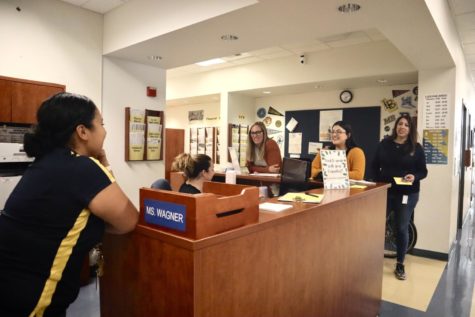
Despite the high need for additional support, the impact that our five counselors have should not be undermined.
“If I have a student that is feeling confident about themselves, that is not feeling inadequate, [they are] going to perform better in school, going to show up every day, going to [be] more likely to stay out of trouble,… and become a productive citizen as well as someone with ambition,” Molina said.
“Now, the more that you take away from us, the more we can’t spend time with those students, the more students we have not coming to school, and the more students we have failing classes.”

Erika Schiesl is a senior and is excited to be a part of the Eagle Times again this year. Aside from writing stories, she also enjoys photography, art,...

Olivia Theaker is a Senior and she's stoked to be on the Eagle times Staff for a second year. She enjoys listening to music, spending time outside, creating...

